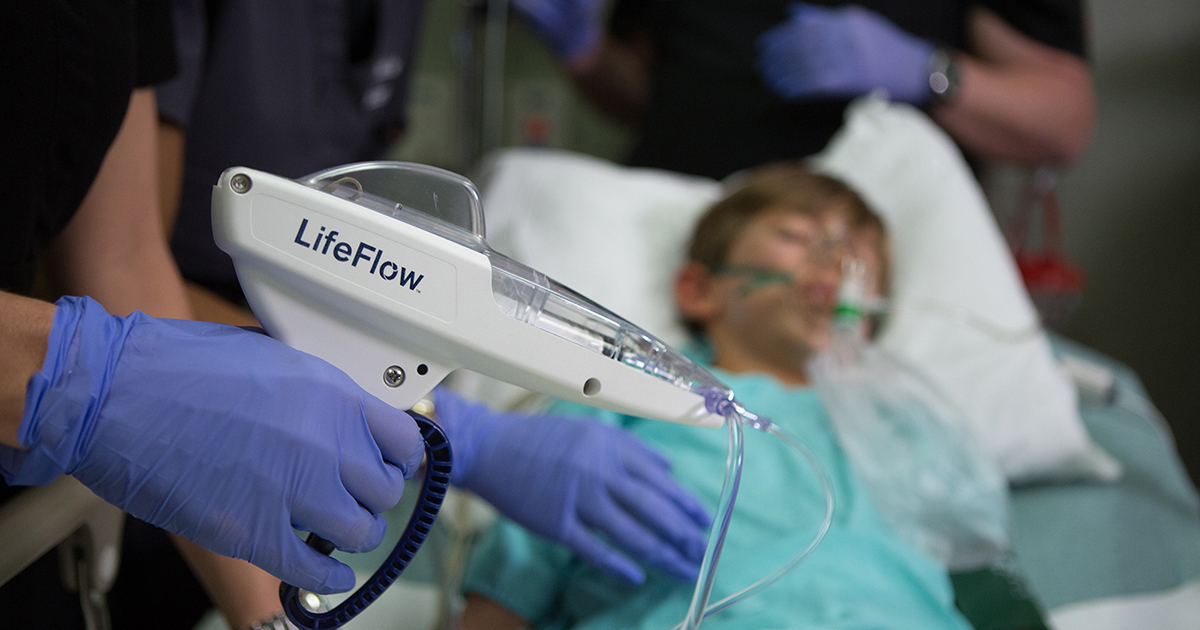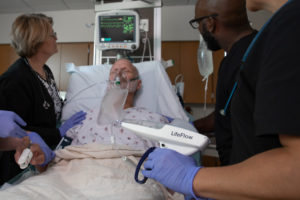
Investment in fluid delivery device pays off
For individuals with suspected cases of sepsis, time is everything. The overwhelming bacterial infection quickly causes the body’s blood pressure to drop, leading to organ damage and even death. Care teams can slow this process by pushing fluids into a person as fast as possible.
The Surviving Sepsis Campaign recommends patients receive fluids within an hour of diagnosis. However, the traditional methods of getting fluids into the body can be slow. They require constant attention. And it can be difficult to determine the volume of fluid delivery. LifeFlow by 410 Medical is cutting the time it takes for fluid replacement by more than half.
The FDA-approved rapid fluid infuser was successfully tested at OSF HealthCare Saint Francis Medical Center in 2018. In October 2019, OSF Ventures became an investor in 410 Medical. LifeFlow is now being used at every hospital across the Ministry for pediatric and adult patients. However, it’s used not just for the treatment of sepsis. It’s also used to care for people in other critical situations.
The importance of fast fluid delivery
It doesn’t take long for young children to lose fluids when they are sick. That was the case when a toddler showed up in the Pediatric Emergency Department at OSF Saint Francis. The child lost a lot of fluid from vomiting and diarrhea and was overly sleepy. Unsure whether the child was suffering from dehydration, a metabolic issue or sepsis, the ED care team had to act fast.
“We used LifeFlow to immediately restore fluids in the toddler,” said Dr. Teresa Riech, medical director of the Pediatric ED at OSF Saint Francis. “Within minutes this young child perked up and looked a lot better. Without this device, it would have taken much more time to infuse the right amount of fluids.”
Before using LifeFlow, hospitals had a variety of ways to rapidly push fluids to patients. This includes gravity infusion, IV pumps and pressure bags. There’s also the “push-pull method” where clinicians repeatedly fill and empty syringes into an IV.
“These methods are not nearly as fast as LifeFlow. They can be inconsistent. And the “push-pull” technique can cause contamination of the IV line,” said Dr. Riech. “This newer medical device gives clinicians more control over fluid delivery and reduces contamination risk.”
Dr. Riech says rapid fluid infusion also allows care teams to quickly reassess their patients, and determine whether additional advanced therapies are needed.
Investing in medical devices
 Many health system-sponsored venture programs restrict their investments to digital solutions. That is not the case with OSF Ventures, the corporate investment arm of OSF HealthCare.
Many health system-sponsored venture programs restrict their investments to digital solutions. That is not the case with OSF Ventures, the corporate investment arm of OSF HealthCare.
“We are a bit unique in our support of med-tech, meaning medical devices and diagnostics,” said Stan Lynall, vice president of Venture Investments. “We believe this gives OSF an edge in getting connected to emerging products our clinicians and patients can benefit from.”
As one of a handful of hospital systems to test LifeFlow, 410 Medical will also soon be testing another device within OSF HealthCare. LifeFlow PLUS is a tool for rapid delivery of blood and blood components, in addition to other fluids for patients with excessive blood loss.